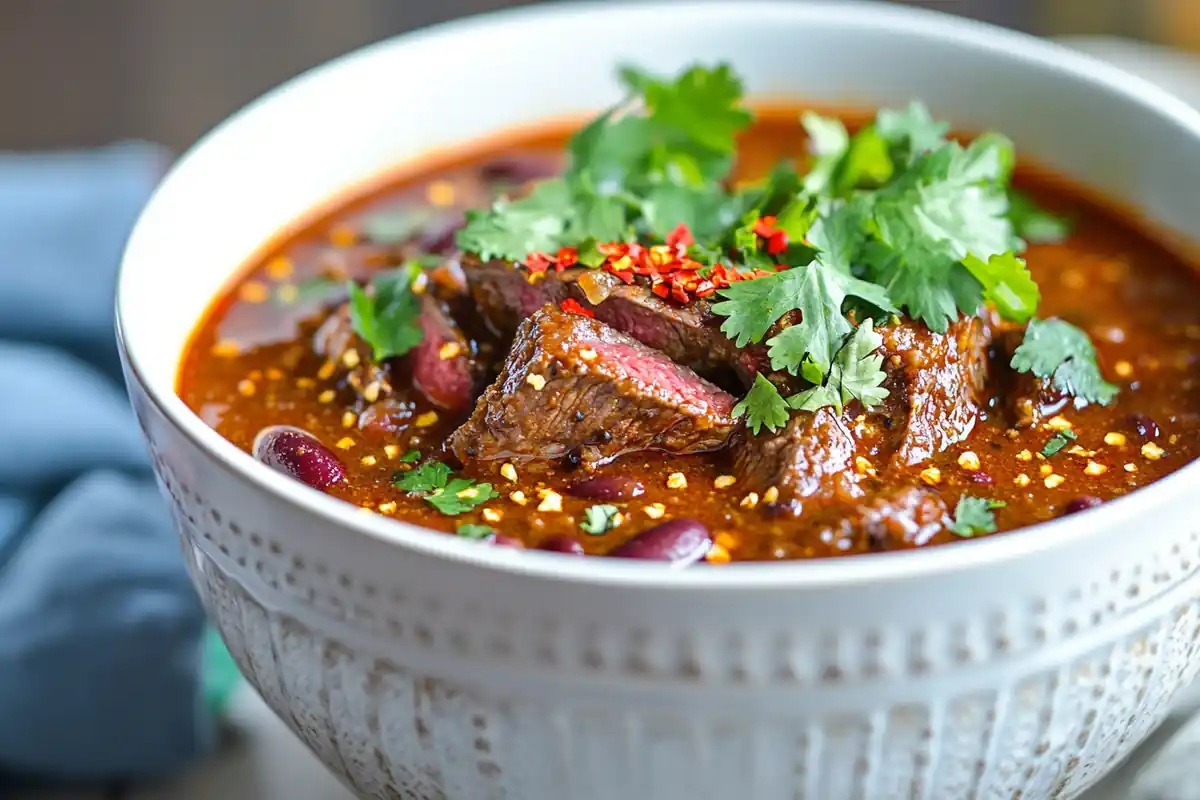When it comes to making mouthwatering chili, the choice of steak can make or break the dish. Chili con carne, a hearty and flavorful stew, relies on the rich, beefy flavors of well-chosen cuts of steak to complement its bold spices. Whether you’re aiming for a smoky, spicy, or savory chili, the type of steak you use will greatly influence its taste and texture. This guide dives into everything you need to know about selecting, preparing, and cooking the best steak for chili, ensuring your dish is a showstopper every time.
Table of Contents
Introduction
Overview of Chili and Its Significance
Chili is more than a dish it’s a cultural icon beloved for its bold flavors and comforting warmth. From its origins as a cowboy staple to its status as a worldwide favorite, chili brings people together with its hearty appeal. At its core, the meat plays a starring role, adding richness and texture to every bite.
Importance of Choosing the Right Steak for Chili
The best steak for chili enhances both flavor and texture, creating a satisfying balance with spices and vegetables. Cuts like chuck, brisket, and short ribs shine when slow-cooked, while leaner options like sirloin offer a lighter twist. Choosing the right steak ensures your chili is not only delicious but also unforgettable.
Understanding Chili and Meat Selection
History of Chili
Chili con carne, meaning “chili with meat,” originated in the American Southwest and evolved into a globally loved dish. Early recipes relied on simple ingredients like dried beef and chilies, but today, chili is a versatile dish with countless variations that highlight the importance of meat as its foundation.
Role of Meat in Chili
Meat is the heart of chili, adding richness and texture. Cuts like chuck steak and brisket bring bold, beefy flavors that pair perfectly with spices, while leaner options like sirloin provide a tender yet mild alternative. The right meat selection can elevate your chili, making it a crowd-pleasing favorite.reate a dish that’s memorable, comforting, and absolutely delicious.
Evaluating Different Cuts of Beef for Chili
Chuck Steak
Chuck steak is often hailed as the best steak for chili, and for good reason. This cut, taken from the shoulder region of the cow, is known for its rich marbling and robust flavor.
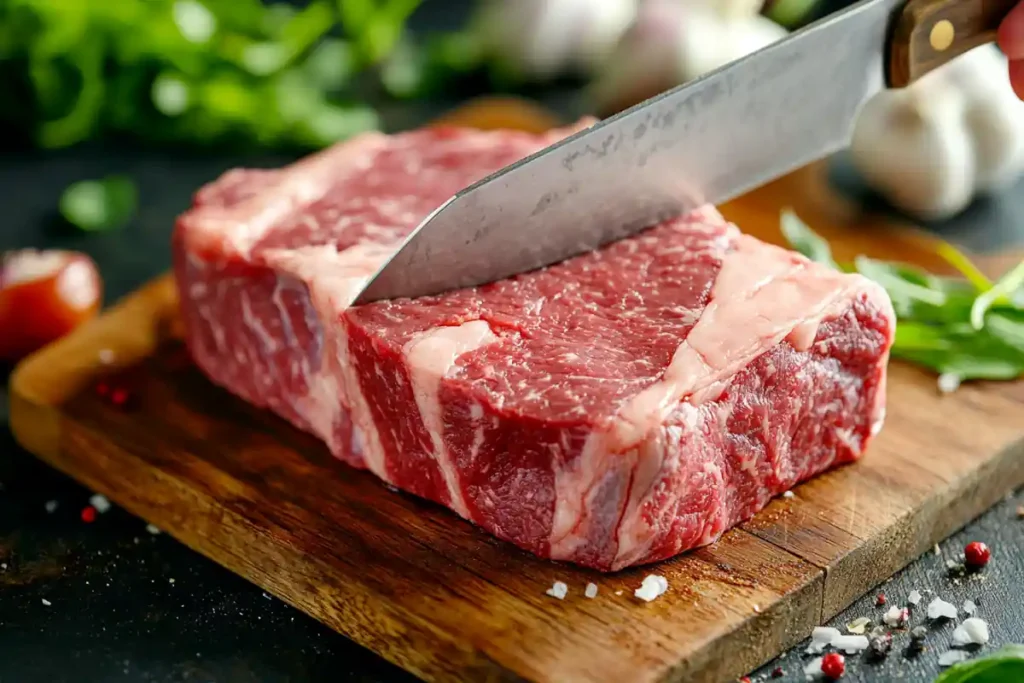
- Characteristics and Flavor Profile: Chuck steak has a high fat content, which renders down beautifully during slow cooking. This not only enhances the flavor of your chili but also adds a silky texture to the sauce.
- Benefits for Chili: Its toughness makes it ideal for recipes requiring extended cooking times. The fibers break down gradually, resulting in tender, juicy chunks of beef that absorb the spices perfectly.
- Cooking Tips: To make the most of chuck steak, dice it into even-sized cubes and sear it over high heat before adding it to your chili pot. This caramelizes the meat, locking in flavor.
Brisket
Brisket is another excellent option for chili lovers seeking a deeper, smokier flavor. Sourced from the breast section, brisket is prized for its tenderness when cooked low and slow.
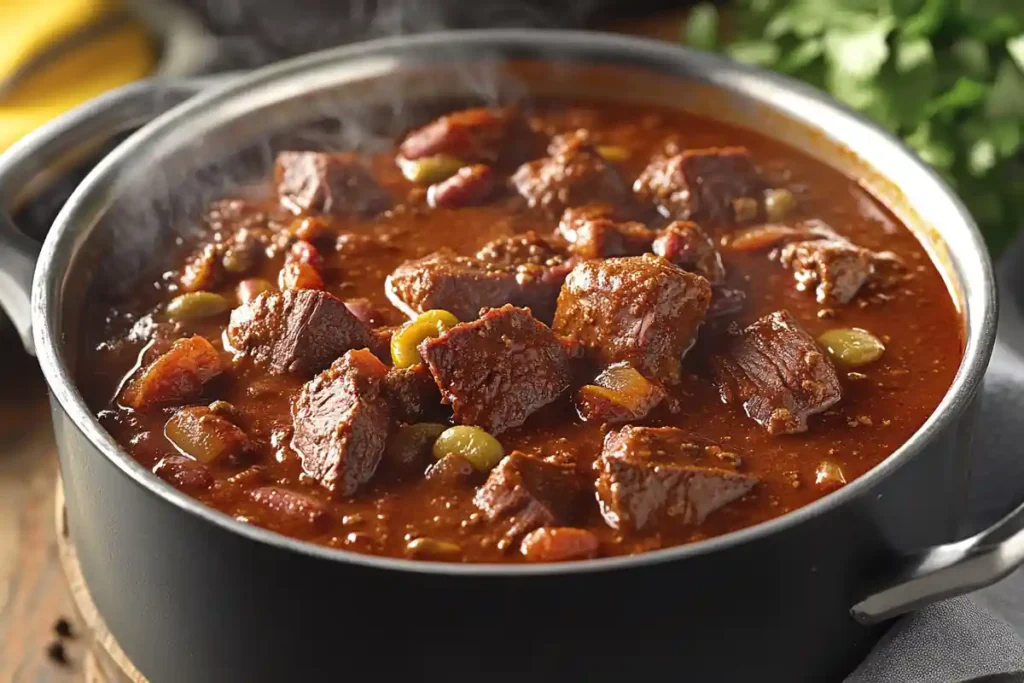
- Overview and Taste Attributes: Brisket has a distinct, beefy flavor that intensifies during prolonged cooking. Its firm texture holds up well in the hearty base of chili.
- Advantages in Chili Recipes: Brisket can elevate your chili by adding layers of complexity. Its fat cap ensures the meat remains moist, even after hours of simmering.
- Preparation Tips: Trim the excess fat before cooking, but leave enough to enhance the flavor. Cut it into bite-sized pieces and let it slowly cook until it practically melts in your mouth.
Short Ribs
If you’re looking for a cut that delivers maximum flavor, short ribs are an outstanding choice. These meaty ribs, taken from the lower rib section, are marbled with fat and connective tissue, making them a dream for chili enthusiasts.
- Description and Flavor Nuances: Short ribs are rich and hearty, with a natural sweetness that pairs beautifully with chili spices.
- Why Use Short Ribs: The collagen in short ribs breaks down during cooking, creating a velvety texture in your chili. The bones, if included, can also contribute an extra depth of flavor.
- Cooking Methods: Consider braising the ribs before adding them to your chili for enhanced flavor. Once cooked, shred the meat off the bones and stir it into the dish.
Ground Beef
While not technically a steak cut, ground beef is a common and versatile choice for chili. Its simplicity and accessibility make it a favorite for weeknight meals.
- Types of Ground Beef: Ground beef comes in different fat ratios, with 80/20 (80% lean, 20% fat) being the most suitable for chili due to its balance of flavor and texture.
- Suitability for Chili: It integrates seamlessly into the chili base, creating a cohesive texture throughout the dish.
- Best Practices: For a chunkier texture, combine ground beef with small pieces of steak like chuck or brisket. Sear it first to enhance the flavor.
Sirloin Steak
Sirloin steak offers a leaner alternative to the fattier cuts often used in chili. Though it requires a more careful approach, its tender and mild nature can be a welcome addition.
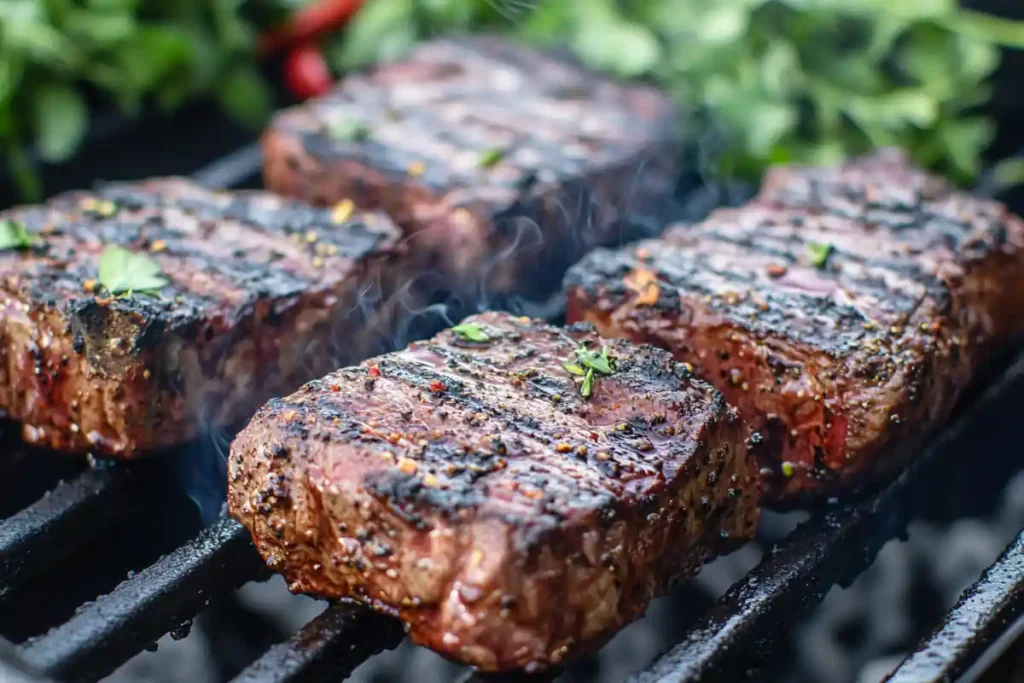
- Features and Taste Profile: Sirloin has less fat but retains a pleasantly beefy taste, making it ideal for lighter chili recipes.
- Using Sirloin in Chili: Add sirloin steak towards the end of cooking to prevent it from drying out. It’s excellent for those who prefer a leaner dish without sacrificing flavor.
- Cooking Tips: Dice the steak into small pieces and sear them quickly to lock in moisture before incorporating them into your chili.
Factors Influencing Steak Selection
Fat Content and Flavor
One of the most critical factors when choosing the best steak for chili is the fat content. Fat isn’t just about richness it’s the key to creating a luxurious texture and carrying the bold spices of chili.
- How Fat Content Affects Flavor: Steak cuts like chuck and brisket, known for their higher fat content, release juices during cooking that blend seamlessly with the chili base. This process deepens the flavor, making each bite more satisfying.
- Balancing Lean and Fatty Cuts: While fat adds flavor, too much can overpower the dish. A smart approach is to mix leaner cuts, like sirloin, with fattier ones, achieving a harmonious balance of taste and texture.
Tenderness and Texture
When it comes to chili, texture matters just as much as flavor. The right steak ensures every spoonful is a perfect combination of tender meat and thick, spicy sauce.
- Importance of Meat Tenderness: Tough cuts, like short ribs and chuck, may seem intimidating, but their toughness turns into melt-in-your-mouth tenderness when slow-cooked. The key lies in breaking down connective tissue during cooking.
- Achieving Desired Texture: Want chili that’s hearty but not chewy? Opt for a mix of chunks and shredded meat. For example, let brisket cook until it falls apart, while diced sirloin can be added later for contrast.
Cost and Availability
Steak cuts vary significantly in price and availability, and knowing your options ensures that your chili stays both delicious and budget-friendly.
- Budget-Friendly Options: Cuts like chuck steak and ground beef are typically affordable and widely available, making them great choices for large batches.
- Accessibility of Various Cuts: Specialty cuts, such as short ribs or brisket, may require a visit to a butcher or specialty market. While pricier, their unique flavors can elevate your chili to gourmet status.
Tips for Choosing the Right Cut for Your Needs
- Consider the Cooking Method: If you’re using a slow cooker or stovetop method, cuts like chuck or brisket perform exceptionally well. For quicker chili recipes, leaner cuts like sirloin may be a better fit.
- Match Your Budget: If you’re cooking for a crowd, ground beef and chuck are economical options that don’t sacrifice flavor.
- Experiment: Don’t be afraid to combine cuts to discover your ideal balance of flavor, texture, and cost. Mixing short ribs with ground beef, for example, can add depth without breaking the bank.
Preparation and Cooking Techniques
Trimming and Cutting the Steak
Proper preparation is the foundation of a delicious chili. When working with steak, trimming and cutting the meat correctly ensures optimal texture and flavor.
- Removing Excess Fat: While fat contributes flavor, too much can result in an overly greasy chili. Trim visible fat from cuts like chuck steak or brisket, leaving just enough to enhance richness.
- Cutting Steak into Appropriate Sizes: Dice the steak into evenly sized cubes, about 1 to 1.5 inches. This size allows the meat to cook evenly and remain tender in the finished dish.
Browning the Meat
Browning the steak is a critical step that often separates good chili from great chili. This technique enhances flavor by developing a deep, caramelized crust.
- Importance of Searing: Searing locks in juices and creates a flavorful foundation for the dish. The Maillard reaction, which occurs during browning, adds complexity to the meat’s taste.
- Techniques for Effective Browning: Use a heavy-bottomed pan or cast-iron skillet. Heat it over medium-high heat, add a small amount of oil, and sear the steak in batches. Avoid overcrowding the pan, as this can cause steaming instead of browning.
Slow Cooking Methods
Chili thrives on patience. Slow cooking not only tenderizes the steak but also melds the flavors of spices, vegetables, and meat into a cohesive masterpiece.
- Benefits of Slow Cooking for Tenderness: Cuts like short ribs and brisket break down beautifully over low heat, resulting in tender, flavorful meat that absorbs the chili base’s bold spices.
- Recommended Appliances and Settings: A slow cooker or Dutch oven is ideal for maintaining a consistent low temperature. Cook your chili on low heat for 6-8 hours, or until the steak is fork-tender.
Deglazing for Maximum Flavor
Don’t let the flavorful browned bits stuck to the pan (fond) go to waste. Deglazing helps capture these rich flavors.
- How to Deglaze: After browning the meat, pour a small amount of beef broth, water, or tomato juice into the hot pan. Use a wooden spoon to scrape up the browned bits, then pour this liquid into your chili base. This step intensifies the dish’s depth of flavor.
Layering Flavors in Your Chili
Building flavor in chili is about more than just choosing the right steak. Layering ingredients during cooking creates a well-rounded, satisfying dish.
- Start with Aromatics: Begin by sautéing onions, garlic, and bell peppers for a fragrant base.
- Add Spices Gradually: Toast your chili powder, cumin, and paprika in the hot pan to release their oils before mixing with other ingredients.
- Incorporate Liquids Thoughtfully: Use beef stock, tomato puree, and a splash of coffee or chocolate to deepen the chili’s complexity.
Enhancing Chili with Additional Ingredients
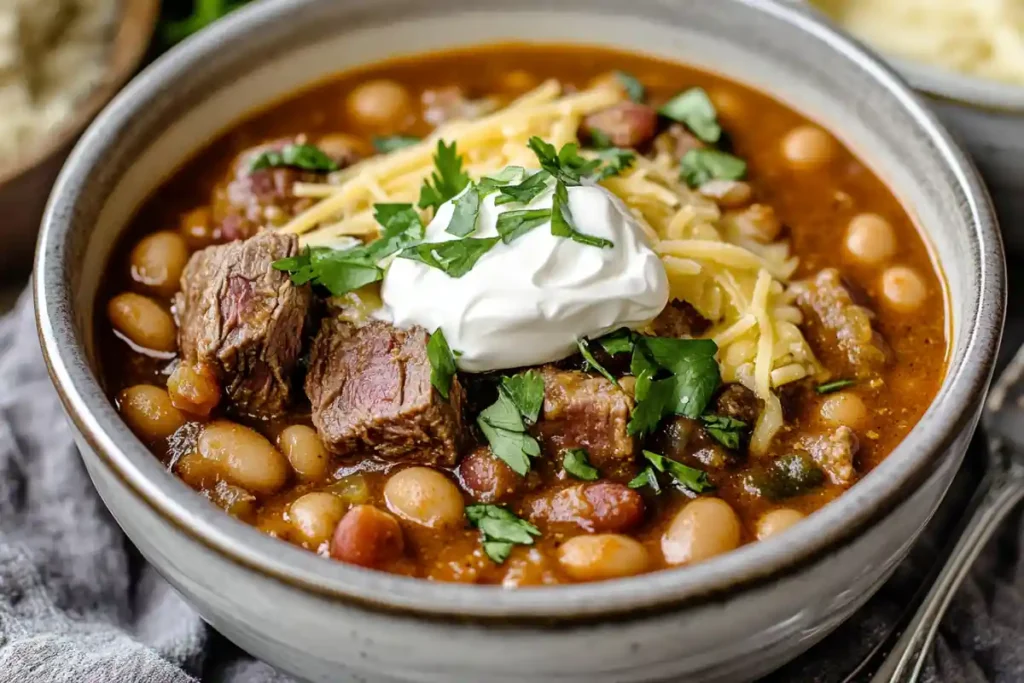
Spice Selection
The spices you use in your chili can take it from ordinary to extraordinary. A thoughtful blend of seasonings enhances the natural flavors of the best steak for chili.
- Essential Spices for Chili:
Key spices like chili powder, cumin, paprika, and oregano form the backbone of a classic chili recipe. Their earthy, smoky flavors complement the rich taste of steak. - Adjusting Spice Levels for Taste:
Not everyone loves fiery heat. Start with moderate amounts of cayenne or red chili flakes, and adjust to your preference as the chili cooks. For added complexity, consider smoked paprika or a pinch of cinnamon.
Incorporating Vegetables
Vegetables play a dual role in chili: they add flavor and boost nutritional value. When paired with steak, they can balance the richness of the meat with fresh, complementary notes.
- Common Vegetables in Chili:
Diced onions, bell peppers, and tomatoes are classic choices. Carrots and celery can also add subtle sweetness and texture. - Impact on Flavor and Nutrition:
Vegetables absorb the flavorful chili base and spices, creating a harmonious balance of textures. They also provide essential vitamins and fiber, making your chili hearty and wholesome.
Beans in Chili
Few topics spark as much debate as beans in chili! Whether you love them or loathe them, beans can add heartiness and stretch your dish to feed a crowd.
- The Great Debate:
Purists argue that traditional chili con carne doesn’t include beans, but they’ve become a popular addition in many regions. - Types of Beans to Consider:
Kidney beans, black beans, and pinto beans are the most common choices. Each adds a unique flavor and texture, enhancing the overall dish. - Adding Beans Without Overpowering:
If using canned beans, rinse them thoroughly to remove excess salt and starch. Stir them in during the last hour of cooking to prevent them from breaking apart.
Garnishes to Elevate Your Chili
The finishing touches on your chili can make a world of difference. Garnishes not only enhance the presentation but also add bursts of flavor and texture.
- Popular Chili Garnishes:
Fresh cilantro, diced green onions, shredded cheese, and sour cream are classics. For extra heat, sprinkle on sliced jalapeños or crushed red pepper flakes. - Creative Additions:
Try crushed tortilla chips for crunch, or a dollop of guacamole for creaminess. A squeeze of lime juice adds brightness and balances the rich flavors.
Balancing Bold Flavors
With so many robust ingredients, achieving balance is key. Too much spice can overwhelm, while too many add-ins can muddy the flavors.
- Tasting and Adjusting:
Taste your chili throughout the cooking process. Need more heat? Add a dash of cayenne. Too salty? A splash of vinegar or a pinch of sugar can bring balance. - Timing Matters:
Add delicate ingredients like fresh herbs and lime juice just before serving to preserve their vibrant flavors.
Frequently Asked Questions (FAQs)
What is the best steak cut for chili?
The best steak for chili depends on your desired texture and flavor. Chuck steak is a top choice due to its marbling and ability to become tender when slow-cooked. Brisket and short ribs are also excellent for their deep, rich flavors. For leaner options, sirloin steak provides a milder taste while still delivering a satisfying bite.
Can I mix different cuts of beef in my chili?
Absolutely! Combining different cuts of steak can add complexity to your chili. For example, mixing chuck steak with short ribs offers a blend of tender chunks and bold flavors. Pairing ground beef with diced steak is another popular approach that balances texture and richness.
Should I marinate the steak before cooking?
While not essential, marinating steak can add extra flavor and tenderize the meat. For chili, a simple marinade with olive oil, garlic, and chili powder works well. However, since the slow-cooking process naturally enhances tenderness, marinating is optional for most cuts.
What are some common mistakes to avoid when making chili?
- Skipping the searing step: Browning your steak before adding it to the chili base builds flavor.
- Overcooking lean cuts: Sirloin and other lean steaks can become chewy if overcooked, so add them later in the cooking process.
- Using too much liquid: A watery chili can dilute the flavors. Start with less liquid and adjust as needed.
- Neglecting seasoning balance: Don’t forget to taste as you cook and balance salty, spicy, and acidic notes.
Conclusion
The secret to exceptional chili lies in choosing the best steak for chili and pairing it with the right spices and techniques. Cuts like chuck, brisket, and short ribs bring richness and depth, while proper preparation ensures tender, flavorful results. With a little care and creativity, you can craft a hearty chili that’s bursting with bold, satisfying flavors every time. So grab your ingredients, and let the simmering begin!

